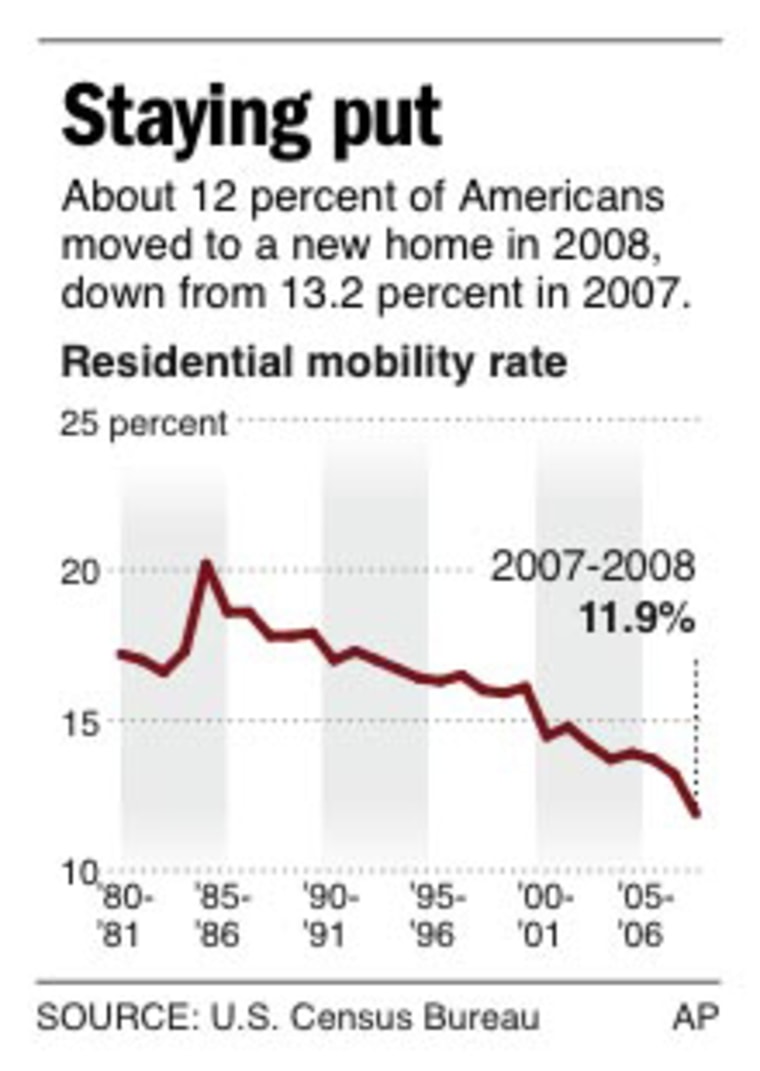The number of Americans who moved declined sharply last year, reaching the lowest percentage in 60 years as people grappled with fewer jobs and tighter credit.
Roughly 11.9 percent of the nation's population — or 35.2 million people — moved to a new home, down from 13.2 percent the previous year, according to census data released Wednesday. It was the sharpest percentage drop in U.S. mobility since the 2000 bursting of the tech bubble, which bankrupted many Internet startups and caused the dwindling of stock portfolios.
The levels of people moving have been declining for decades, more recently due to an aging boomer population that is less mobile, since hitting a peak of 21 percent in 1951. But the rate had generally leveled off at around 13 to 14 percent before last year's drop.
Longer-distance moves between states have dropped 36 percent since 2005 to about 4.7 million, reflecting the housing downturn.
Decline in housing market playing role
William Frey, a demographer at Brookings Institution, said declining U.S. migration to residential magnets in the suburbs and exurbs, and particularly in the Sunbelt, were driving the low moving rates overall.
In 2008, the Northeast continued to lose the most residents, but at a slower rate than previous years. The South registered a net gain of people moving in, while the West and Midwest had declines.
"It's a combination of the inability to buy or sell homes, locally, as well as a drying up of jobs particularly in hot housing markets," he said. "The lure of the suburbs for immigrants, in particular, has been curtailed as homeownership there has proved to be elusive."

The demographic numbers highlight the task ahead for the bureau, which is gearing up for next year's decennial head count that will be used to apportion House seats.
The unemployed, minorities and poor people were more likely to move, according to the data. Immigrants increasingly headed to dense urban areas rather than the wide-open suburbs compared to years past, underscoring government concerns that these groups will prove difficult to count. The bureau has said that tens of millions of residents are at risk of being missed in cities such as Los Angeles and New York, particularly non-English speaking people and displaced homeowners.
Other findings:
- About 55 percent of immigrants moved directly from their own countries to the cities, compared to 37 percent who moved to the suburbs and 8 percent to rural areas. Earlier in the decade, immigrants had flocked to cities and suburbs in nearly equal numbers.
- The most commonly cited reasons for moving were a desire to own a home or live in a better neighborhood, representing 40 percent of movers. Other factors included family (30.5 percent) and jobs (21 percent).
- Among those who moved, 65 percent moved within the same county, 18 percent moved to a different county within the same state, 13 percent moved to a different state, and 3 percent moved to the U.S. from another country.
- About 28 percent of renters moved in the previous year, five times the rate of homeowners.
The number of immigrants coming to the U.S. from other countries was the lowest in more than a decade.
"Even though the number of people who changed residence in 2008 dropped by 3.5 million from the previous year, millions of Americans continue to move," said Tom Mesenbourg, the Census Bureau's acting director. "As we gear up for the 2010 census, we will be looking to get an accurate count of everyone in the country."
The census data was based on the Current Population Survey as of April 2008. The government first began tracking movers in 1948.